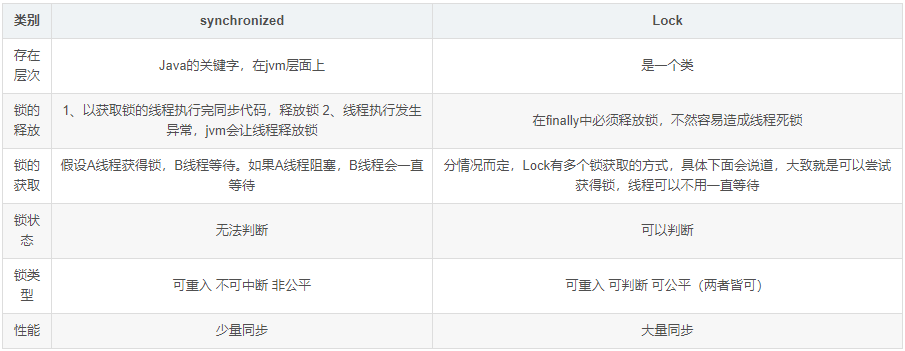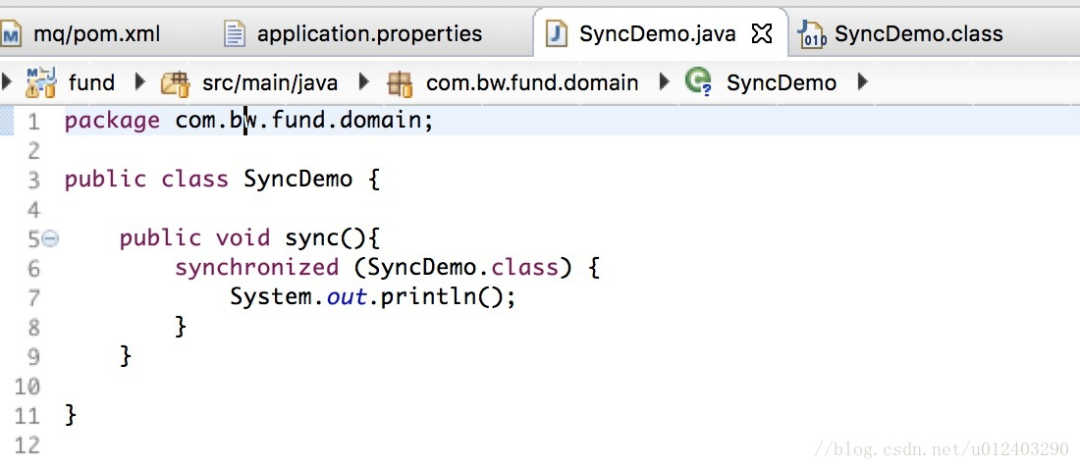【72期】面试官:对并发熟悉吗?说一下synchronized与Lock的区别与使用
阅读本文大概需要 8 分钟。
来自:https://blog.csdn.net/u012403290/
引言:
技术点:
1、线程与进程:
2、Thread的几个重要方法:
start()方法,调用该方法开始执行该线程;
stop()方法,调用该方法强制结束该线程执行;
join方法,调用该方法等待该线程结束。
sleep()方法,调用该方法该线程进入等待。
run()方法,调用该方法直接执行线程的run()方法,但是线程调用start()方法时也会运行run()方法,区别就是一个是由线程调度运行run()方法,一个是直接调用了线程中的run()方法!!
3、线程状态:

新建状态:新建线程对象,并没有调用start()方法之前
就绪状态:调用start()方法之后线程就进入就绪状态,但是并不是说只要调用start()方法线程就马上变为当前线程,在变为当前线程之前都是为就绪状态。值得一提的是,线程在睡眠和挂起中恢复的时候也会进入就绪状态哦。
运行状态:线程被设置为当前线程,开始执行run()方法。就是线程进入运行状态
阻塞状态:线程被暂停,比如说调用sleep()方法后线程就进入阻塞状态
死亡状态:线程执行结束
4、锁类型
可重入锁:在执行对象中所有同步方法不用再次获得锁
可中断锁:在等待获取锁过程中可中断
公平锁:按等待获取锁的线程的等待时间进行获取,等待时间长的具有优先获取锁权利
读写锁:对资源读取和写入的时候拆分为2部分处理,读的时候可以多线程一起读,写的时候必须同步地写
synchronized与Lock的区别

Lock详细介绍与Demo
public interface Lock {
/**
* Acquires the lock.
*/
void lock();
/**
* Acquires the lock unless the current thread is
* {@linkplain Thread#interrupt interrupted}.
*/
void lockInterruptibly() throws InterruptedException;
/**
* Acquires the lock only if it is free at the time of invocation.
*/
boolean tryLock();
/**
* Acquires the lock if it is free within the given waiting time and the
* current thread has not been {@linkplain Thread#interrupt interrupted}.
*/
boolean tryLock(long time, TimeUnit unit) throws InterruptedException;
/**
* Releases the lock.
*/
void unlock();
}
lock():获取锁,如果锁被暂用则一直等待
unlock():释放锁
tryLock(): 注意返回类型是boolean,如果获取锁的时候锁被占用就返回false,否则返回true
tryLock(long time, TimeUnit unit):比起tryLock()就是给了一个时间期限,保证等待参数时间
lockInterruptibly():用该锁的获得方式,如果线程在获取锁的阶段进入了等待,那么可以中断此线程,先去做别的事
lock():
package com.brickworkers;
import java.util.concurrent.locks.Lock;
import java.util.concurrent.locks.ReentrantLock;
public class LockTest {
private Lock lock = new ReentrantLock();
//需要参与同步的方法
private void method(Thread thread){
lock.lock();
try {
System.out.println("线程名"+thread.getName() + "获得了锁");
}catch(Exception e){
e.printStackTrace();
} finally {
System.out.println("线程名"+thread.getName() + "释放了锁");
lock.unlock();
}
}
public static void main(String[] args) {
LockTest lockTest = new LockTest();
//线程1
Thread t1 = new Thread(new Runnable() {
@Override
public void run() {
lockTest.method(Thread.currentThread());
}
}, "t1");
Thread t2 = new Thread(new Runnable() {
@Override
public void run() {
lockTest.method(Thread.currentThread());
}
}, "t2");
t1.start();
t2.start();
}
}
//执行情况:线程名t1获得了锁
// 线程名t1释放了锁
// 线程名t2获得了锁
// 线程名t2释放了锁
tryLock():
package com.brickworkers;
import java.util.concurrent.locks.Lock;
import java.util.concurrent.locks.ReentrantLock;
public class LockTest {
private Lock lock = new ReentrantLock();
//需要参与同步的方法
private void method(Thread thread){
/* lock.lock();
try {
System.out.println("线程名"+thread.getName() + "获得了锁");
}catch(Exception e){
e.printStackTrace();
} finally {
System.out.println("线程名"+thread.getName() + "释放了锁");
lock.unlock();
}*/
if(lock.tryLock()){
try {
System.out.println("线程名"+thread.getName() + "获得了锁");
}catch(Exception e){
e.printStackTrace();
} finally {
System.out.println("线程名"+thread.getName() + "释放了锁");
lock.unlock();
}
}else{
System.out.println("我是"+Thread.currentThread().getName()+"有人占着锁,我就不要啦");
}
}
public static void main(String[] args) {
LockTest lockTest = new LockTest();
//线程1
Thread t1 = new Thread(new Runnable() {
@Override
public void run() {
lockTest.method(Thread.currentThread());
}
}, "t1");
Thread t2 = new Thread(new Runnable() {
@Override
public void run() {
lockTest.method(Thread.currentThread());
}
}, "t2");
t1.start();
t2.start();
}
}
//执行结果: 线程名t2获得了锁
// 我是t1有人占着锁,我就不要啦
// 线程名t2释放了锁
/**
* Sync object for non-fair locks
*/
static final class NonfairSync extends Sync {
private static final long serialVersionUID = 7316153563782823691L;
/**
* Performs lock. Try immediate barge, backing up to normal
* acquire on failure.
*/
final void lock() {
if (compareAndSetState(0, 1))
setExclusiveOwnerThread(Thread.currentThread());
else
acquire(1);
}
protected final boolean tryAcquire(int acquires) {
return nonfairTryAcquire(acquires);
}
}
/**
* Sync object for fair locks
*/
static final class FairSync extends Sync {
private static final long serialVersionUID = -3000897897090466540L;
final void lock() {
acquire(1);
}
/**
* Fair version of tryAcquire. Don't grant access unless
* recursive call or no waiters or is first.
*/
protected final boolean tryAcquire(int acquires) {
final Thread current = Thread.currentThread();
int c = getState();
if (c == 0) {
if (!hasQueuedPredecessors() &&
compareAndSetState(0, acquires)) {
setExclusiveOwnerThread(current);
return true;
}
}
else if (current == getExclusiveOwnerThread()) {
int nextc = c + acquires;
if (nextc < 0)
throw new Error("Maximum lock count exceeded");
setState(nextc);
return true;
}
return false;
}
}
public ReentrantLock() {
sync = new NonfairSync();//默认非公平锁
}
尾记录:
补充
1、两种锁的底层实现方式:


那如何教育呢?
1、线程自旋和适应性自旋
2、锁消除
String str1="qwe";
String str2="asd";
String str3=str1+str2;
StringBuffer sb = new StringBuffer();
sb.append("qwe");
sb.append("asd");
3、锁粗化
4、轻量级锁
5、偏向锁
推荐阅读:
【71期】面试官:对并发熟悉吗?谈谈你对Java中常用的几种线程池的理解
【70期】面试官:对并发熟悉吗?谈谈对volatile的使用及其原理
【69期】面试官:对并发熟悉吗?谈谈线程间的协作(wait/notify/sleep/yield/join)
微信扫描二维码,关注我的公众号
朕已阅 

